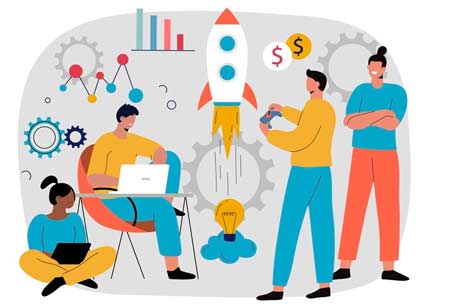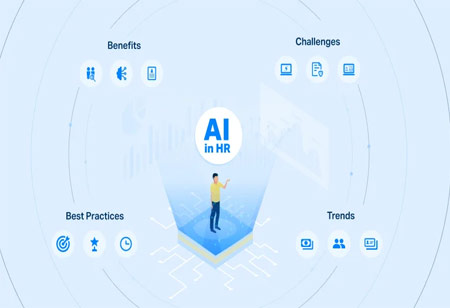THANK YOU FOR SUBSCRIBING
Be first to read the latest tech news, Industry Leader's Insights, and CIO interviews of medium and large enterprises exclusively from Hrtech Outlook
THANK YOU FOR SUBSCRIBING

By
HR Tech Outlook | Monday, August 25, 2025
Stay ahead of the industry with exclusive feature stories on the top companies, expert insights and the latest news delivered straight to your inbox. Subscribe today.
FREMONT, CA: Organizations continuously seek innovative methods to enhance employee engagement and satisfaction in today's rapidly evolving digital landscape. Technology integration into the workplace has revolutionized how companies interact with their employees, offering various tools and platforms designed to improve the overall employee experience.
Streamlined Communication and Collaboration
One of the most significant impacts of technology on the workplace is the transformation of communication and collaboration. Platforms like Slack, Microsoft Teams, and Zoom have become essential tools for maintaining seamless communication, particularly in remote and hybrid work environments. These tools offer instant messaging, video conferencing, and project management capabilities, ensuring effective collaboration regardless of physical location.
These platforms foster a culture of open and transparent communication, helping build strong team dynamics and enhancing employee engagement. Employees feel more connected and valued when they can easily share ideas and receive real-time feedback.
Personalized Employee Experiences
Advanced HR technologies and employee management systems enable a more personalized employee experience. Tools such as SAP SuccessFactors and Workday allow HR professionals to track employee performance, preferences, and career aspirations. This data can tailor development programs, recognition systems, and career advancement opportunities to meet individual employee needs.
Personalization not only addresses the unique needs of each employee but also demonstrates that the organization values their contributions and is invested in their growth, leading to increased job satisfaction and loyalty.
Continuous Learning and Development
The digital age has ushered in a new era of continuous learning and development. Online learning platforms like LinkedIn Learning, Coursera, and Udemy offer employees the flexibility to learn at their own pace and schedule. These platforms provide various courses and training programs that employees can access to enhance their skills and knowledge.
Promoting a continuous learning culture can help organizations keep their workforce engaged and motivated. Employees are more likely to stay with a company that invests in their professional development and provides opportunities for growth and advancement.
Enhanced Employee Recognition and Rewards
Technology has revolutionized how organizations recognize and reward their employees. Platforms like Bonusly, Achievers, and Kudos provide a digital space where employees can give and receive recognition in real-time. These platforms often integrate with social media, allowing for public recognition of achievements and contributions.
A robust recognition and rewards system can significantly boost employee morale and motivation. Employees who feel appreciated and recognized for their hard work are more likely to be engaged and satisfied.
Well-being and Work-Life Balance
The digital age has increased awareness of the importance of employee well-being and work-life balance. Wellness apps and platforms like Headspace, Calm, and Virgin Pulse offer resources and tools to help employees manage stress, improve mental health, and maintain a healthy work-life balance.
Organizations that prioritize employee well-being and offer tools to support it can foster a more positive and productive work environment. Employees who feel their well-being is supported are likelier to be engaged and satisfied with their work.
Data-Driven Decision Making
Big data and analytics have enabled organizations to make more informed decisions regarding employee engagement and satisfaction. HR analytics tools can track various employee performance, engagement, and turnover metrics. This data can be used to identify trends, pinpoint areas for improvement, and develop strategies to enhance the overall employee experience.
Organizations can create targeted interventions that address specific issues and improve employee satisfaction by leveraging data-driven insights. This proactive approach can lead to a more engaged and motivated workforce.
The digital age offers organizations a wealth of opportunities to enhance employee engagement and satisfaction through technology. Companies can create a more engaging and satisfying work environment by leveraging advanced communication tools, personalized experiences, continuous learning platforms, recognition and rewards systems, well-being resources, and data-driven decision-making.
As technology continues to evolve, so will the strategies for enhancing the employee experience. Organizations that stay ahead of the curve and embrace these technological advancements will be better positioned to attract, retain, and motivate top talent in the competitive landscape of the digital age.
I agree We use cookies on this website to enhance your user experience. By clicking any link on this page you are giving your consent for us to set cookies. More info

However, if you would like to share the information in this article, you may use the link below:
www.hrtechoutlookeurope.com/news/how-tech-creates-a-culture-of-connection-growth-nid-3946.html



